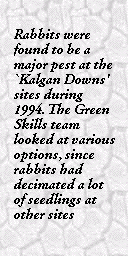
Bob Bairstow, Woogenellup East

|
Upper Kalgan River restoration and protection
Bob Bairstow, Woogenellup East |
 |
Background
Bob Bairstow was the owner of "Kalgan Downs" until March 1997 when Ken and Judy Hunt purchased it. The farm got its name from the Kalgan River, which flows through the property on its way to Oyster Harbour about 40 kilometres to the south. The property is situated in the upper one third of the catchment and farming activities include sheep grazing and cropping. The property was one of the first to be developed in the area and has been settled for more than 60 years. The original vegetation along the river was flooded gum, paperbark, yate, tea-tree, samphire and rushes and sedges. Some original vegetation remains but much of it has been removed by stock grazing and trampling. A project was undertaken during 1994 to 1996 to fence off and restore about 45 hectares of badly degraded riparian zone along the Upper Kalgan River. Green Skills were contracted to carry out the works for the Albany Waterways Management Authority with funding from the Natural Heritage Trust. Subsidies were provided to farmers to fence off the areas for rehabilitation by funding obtained through the Oyster Harbour Catchment Group. At the end of the project a total of 31,112 trees had been planted on 42 sites on 21 properties covering an area of almost 45 hectares. 'Kalgan Downs' had works carried out on five sites along the river, totalling an area of about eight hectares.
The project was initiated to help to address concerns over the health of the Oyster Harbour and of the Kalgan River itself. Stock had access along much of the foreshore and riparian vegetation was declining in health. Erosion gullies were present in some areas and there was concern over the amount of sediment and nutrients being transported downstream to the Oyster Harbour. A flood in 1982 drastically changed the river and did most of the damage, such as the erosion, that we see at the site today. The Solution In 1994 Green Skills assisted Bob to plant trees at four sites along the Kalgan River. One site had been fenced and the remaining three sites were fenced as part of a Landcare Environment Action Program (LEAP). A local contractor using a backpack and a mixture of 'Brushoff' and 'Roundup' to target broad leaf weeds carried out the first spraying of weeds in June. A second spraying was carried out in July using a mixture of 'Roundup' and 'Simazine' to give residual weed control for up to six months. The Department of Conservation and Land Managements Sharefarming unit and Agriculture Western Australia gave recommendations for weed control.
Rabbits were a problem and during September 1994 rabbit guards that had been made by the LEAP participants were put around the trees. The site was inspected at this time and it was estimated that there was a tree survival rate of 85-98% overall on all replanted sites. During 1995 a further two hectare site was revegetated along the Kalgan River at the western end of the 1994 plantings. This site was mounded in 1994 and then the mounds were ripped in May 1995. The site was sprayed once for weeds in June 1995 using a combination of knockdown and residual sprays. This required a higher concentration of 'Roundup' but decreased the application time by half. The rates were as follows:
Roundup: 1.5 litres per hectare A total of 2132 trees were planted two weeks after spraying and included Eucalyptus rudis, E. occidentalis, E. tetragona, Melaleuca viminea, Agonis parviceps, Acacia myrtifolia, A. saligna and Allocasuarina obesa. The row space was decreased to 3 metres and the plant space to 1 metre to increase the density of the revegetation as compared to that in 1994. Rabbit control was not required for this site in 1995. During 1996 a further 1280 trees were planted at a four hectare site adjoining the 1995 site. This site included a large washout with steep eroded banks. The area was spot sprayed for weeds in July 1996. The species planted included Eucalyptus rudis, E. occidentalis, E. wandoo, E. eremophila, Melaleuca incana, Acacia saligna, Agonis linearifolia, Allocasuarina obesa, and Callistemon phoenicius. Outcomes and observations Over the three-year project the supervisors of the works documented the achievements and problems associated with it and made recommendations for future similar works. In general they found that the weed control methods were effective for most sites as long as the spraying and planting program was adhered to. It was important to spray as soon as the weeds had germinated after the first rains of the season. One of the landholders suggested carrying out an additional spray six months prior to the trees being planted. This was only recommended if the areas to be planted were fenced, as stock access to an area bare of weeds could exacerbate wind erosion at susceptible sites. It was also recommended that the ripping and mounding of sites occur a lot earlier than had been done in 1994 and a long time before weed control. Mound height should also be decreased especially in sandy soils as a high mound contributed to drying out during summer. More consultation should also have been carried out as to the soil types of the areas to enable a more specific treatment method to be employed at each site. Some of the sites were on deep sand and ungrazed, and therefore they only required weed control prior to planting. Others were grazed and required ripping to break up the compacted soil as well as weed control. The waterlogged sites needed mounding as well as ripping and weed control. The method of lightly compacting the mounds was highly recommended as it was found to help retain soil moisture, especially during dry times of the year. A landholder suggested that this be carried out 12 months prior to planting. Again this was only recommended if stock were kept off the site for the whole period before planting. Rabbits were found to be a major pest at the 'Kalgan Downs' sites during 1994. The Green Skills team looked at various options, since rabbits had decimated a lot of seedlings at other sites. Bait trails using 1080 were found only to be effective over the short term as rabbits moved in from neighbouring areas about three months after baiting. The use of tree guards was highly successful, especially if they were put on immediately after planting and left on for two years. The tree guards were made from 300 millimetre wide strips of two inch hexagonal galvanised mesh cut in a jig and bent around into a cylinder on site. They cost about 40 cents each in materials and were very effective at protecting the seedlings and they were also reusable. A trial was carried out planting trees through sheets of newspaper and the results were amazing. Kevin Hopkinson said: "All the trees not planted in newspaper had been eaten, whilst all the ones in the paper were untouched. The site was in a particularly sandy area, and the paper obviously retained moisture in the soil, as the trees were much healthier than nearby plants with only wire guards around them. The placement of the newspaper was a very labour intensive job, but it does appear to have multiple benefits to the trees and so is worthy of consideration for future work".
Kalgan River catchment statistics
|
||||||||||||
 |
|||||||||||||
 |
|||||||||||||